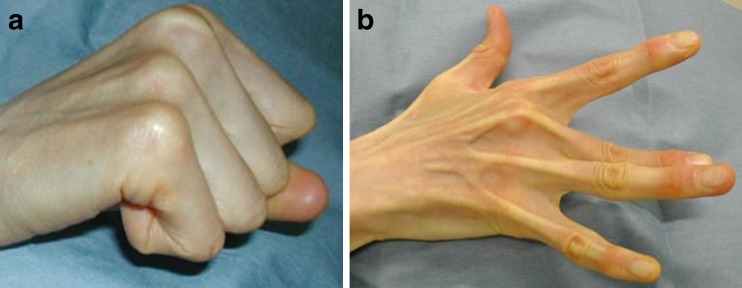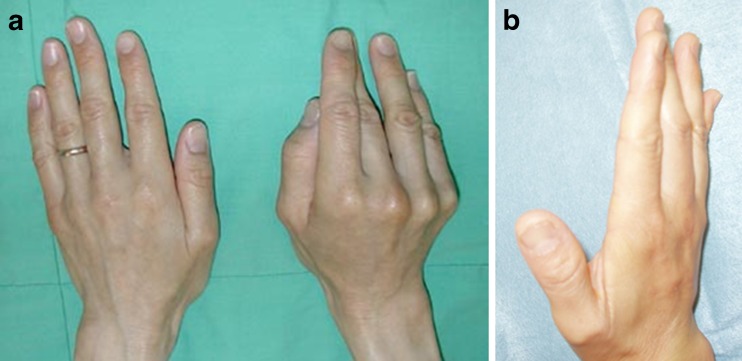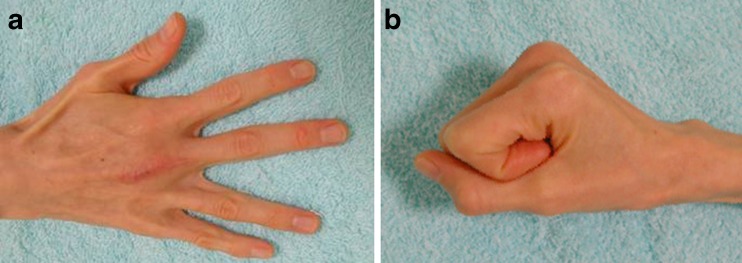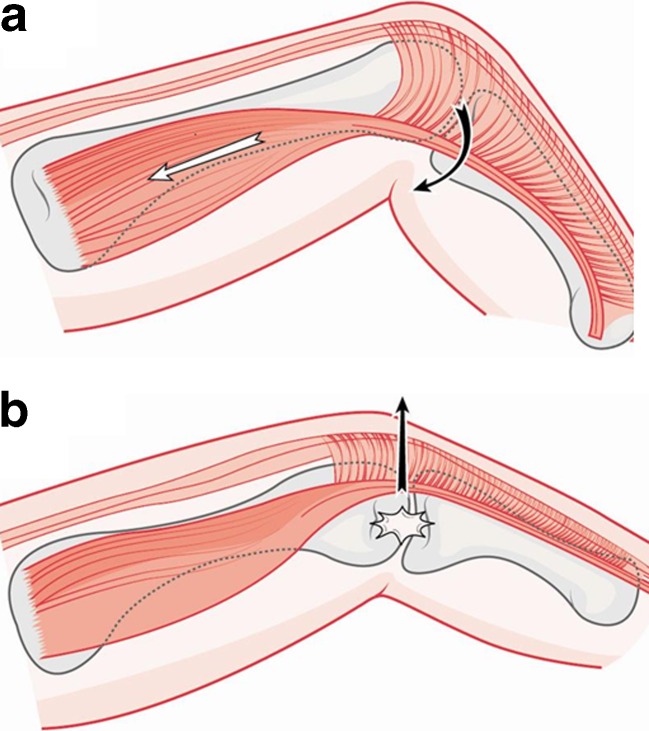Introduction
The incidence of eating disorders is growing and is twice as common among women as men. Atrophy of the intrinsic muscles causes the fingers to stiffen and the hand to become deformed and functionally disabled. Trauma limited to the hand, inflammation, spasticity, central nervous system disease, prolonged spasm, and excessive immobilization can cause such muscle contracture [1, 2, 4, 5, 7–9, 12]. Metacarpophalangeal (MP) joint locking is known to be caused by muscular contracture or trauma, collateral ligament, or volar plate tethering on a prominent MP head or osteophyte, a torn palmar plate, metacarpal head fracture, a loose body, or abnormal sesamoids [10, 11]. We report the very rare cause of MP joint snapping with intrinsic plus deformity, which finally became locked.
Case Report
The affected side was the right dominant side in all three cases (Table 1). All patients were excessively thin young women, whose mean body mass index (BMI) and age were 13.9 and 33 years, respectively. Two patients had psychological conditions diagnosed as anorexia nervosa. The other patient has been treated for neurosis by antidepressant drugs. Central nervous disease including an extrapyramidal tract disorder, dystonia, peripheral nerve disorder, or myotonia was ruled out by physicians in the Neurological Department. They have no other deficiencies or abnormal function at other joints/limbs. For the differential diagnosis of MP joint locking, all of the common causes were eliminated after the consideration of X-rays of the hand. The initial symptoms were reducible snapping of the MP joints with intrinsic tightness. Several months after the initial symptoms, all patients experienced irreducible locking of the MP joints, and intrinsic plus contracture was observed at that time (as shown in Figs. 1 and 4a). All patients were initially treated conservatively using dynamic splinting, i.e., reverse knuckle bender. All patients were treated surgically at 2 to 9 months after the initial consultation because the locking was not improved conservatively. The surgical procedure was performed according to Bunnell’s staged strategy with some modification, which aimed to minimize the functional loss of interosseous muscle, following the dorsal approach [3, 7]. When the intrinsic tightness was released by sliding the interosseous muscle from the metacarpal bone, the surgery was finished. If the intrinsic tightness was not released enough to unlock the MP joint, the lateral band and oblique fibers were cut at the level of the proximal phalanx, as a second procedure within the same operative setting. Locking between the extensor hood and metacarpal head was frequently observed during loosening the tensed extensor lateral band. There were no MP joint contractures. All the interosseous muscles were biopsied before sliding from the metacarpal bone. The proliferation of fibroblasts and collagen fibers with some myxoid degeneration had entered the skeletal muscle fibers. The lesion was histologically equivalent to fibromatosis in all three cases. No sign of recurrence was observed during the mean 8 month follow-up period.
Table 1.
Demographic and clinical data for patients
| Case | Causative local factors | Age | Gender | Height (m) | Weight (kg) | BMI | Past history | Affected fingers | Surgical method | |
|---|---|---|---|---|---|---|---|---|---|---|
| 1 | None | 32 | Female | 1.52 | 32 | 13.9 | Anorexia | Rt | Middle | 1st and 2nd step |
| Nervosa | ||||||||||
| 2 | None | 30 | Female | 1.54 | 28 | 11.8 | Anorexia | Rt | Ring | 1st step |
| Nervosa | ||||||||||
| 3 | None | 38 | Female | 1.55 | 38 | 16 | Neurosis | Rt | Index | 1st step |
| Middle | 1st and 2nd step | |||||||||
| Ring | ||||||||||
| Mean | 33 | 1.54 | 33 | 13.9 | ||||||
Surgical method: First step, interosseous muscle slide; second step, removal of the lateral band and oblique fibers
Fig. 1.
Case 1. General appearance of the right hand. a The patient was able to achieve full flexion. b At the finger extension, the MP joint could not be extended because of locking
Fig. 4.
Case 2. a General appearance of both hands at the initial consultation. Upon finger extension, intrinsic plus deformity was observed, and the MP joint could not be extended because of intrinsic tightness at the affected right hand. The symptom was irreversible locking of the right middle finger and reversible locking of the ring and index fingers. An intrinsic plus contracture was observed at the initial consultation. b General appearance of the affected right hand at 6 months after surgery. At finger extension, the intrinsic plus deformity was improved, and the MP joint could be extended
Case 1
This patient had received medication for anorexia nervosa for several years. The patient experienced locking of the right middle finger, which she could not unlock by herself a few months after the initial reducible locking (Fig. 1). The middle finger was deviated in the volar and ulnar directions. This patient was treated surgically at 3 months after the initial consultation because the locking was not improved by conservative methods. During the operation (Fig. 2), the intrinsic extensor tendon, which exhibited strong tension, was observed in a deep volar position. Locking between the intrinsic extensor tendon and metacarpal head was observed. Resection of the ulnar intrinsic extensor tendon in addition to proximal intrinsic muscle slide released the locking and improved ulnar drift as well as intrinsic tightness. Intrinsic tightness was improved, and no signs of recurrence were noted during the 6-month follow-up period (Fig. 3).
Fig. 2.
Case 1. Intraoperative photograph. There was severe deviation in the volar direction of the intrinsic extensor tendon of the middle finger. The arrows indicate a sliding of the proximal intrinsic muscle insertion and b the intrinsic extensor tendons with strong tension in the deep volar position. Locking between the intrinsic extensor tendons with strong tension in the deep volar position (arrow in b) and metacarpal head was observed. This intrinsic extensor tendon with strong tension in the deep volar position moved to the dorsal surface of the metacarpal head with unlocking upon extension of the MP joints
Fig. 3.
Case 1. Postoperative photograph at 6 months after the surgery. Improvement of ulnar drift as well as intrinsic tightness was observed. No sign of recurrence was noted a at finger extension and abduction and b at finger flexion
Case 2
This patient showed similar symptoms of case 1. She had received medication for anorexia nervosa for 1 year. Approximately 12 months after the patient experienced ring finger pain similar to flexor tenosynovitis symptoms, including tenderness on the palmar side of the MP joint, she felt reversible locking of the MP joints; intrinsic tightness was also observed at that time based on a positive intrinsic tightness test. Several months after the initial episode, the patient experienced locking of the right ring finger, which she could not unlock by herself. During the operation, the intrinsic extensor tendon, which exhibited strong tension, was observed in the deep volar position. Locking between the intrinsic extensor tendon and metacarpal head was observed. Proximal intrinsic muscle slide released the locking and improved the ulnar drift as well as the intrinsic tightness. Intrinsic tightness was improved, and no sign of recurrence was noted during the 1-year follow-up.
Case 3
In this patient, the initial symptom was locking of her right index, middle, and ring fingers. Several months after the initial episode, the patient was not able to unlock the middle finger and visited a doctor, who found intrinsic plus contracture at that time (Fig. 4a). Nine months after the initial episode, the patient was operated on. The intrinsic tightness test at MP joint extension was strongly positive in her middle and ring fingers, weakly positive in the index finger, and negative in the little finger. No bone or joint abnormality was observed by radiograph; only intrinsic plus deformity due to intrinsic tightness was recognized. At surgery, using a dorsal approach, the atrophic proximal intrinsic muscle was slide, as a first step. No significant improvement of the severely contracted middle and ring fingers was observed after this step. Next, the intrinsic extensor tendon was resected at a more distal site over the proximal phalanx of the middle and ring fingers. Intrinsic tightness improved, and no sign of recurrence was noted during the 6-month follow-up period (Fig. 4b).
Discussion
In the surgically treated fingers, locking between the extensor hood and metacarpal head was observed during surgery, and the lateral band was very tense. Therefore, the MP joint locking at the initial stage seemed to have occurred as shown by a schema in Fig. 5.
Fig. 5.
Schematic drawing of the reversible locking (snapping) mechanism at the early stage between the extensor hood and metacarpal head. The lateral band snapped palmar to the axis of the MP joint in flexion due to the shortened muscle/tendon unit of the interosseous muscle. a Locking in flexion of the MP joint is caused by deviation of the tense extensor lateral band deep in the palmar direction, after being pulled by increased tension in the atrophic interosseous muscle. b Unlocking with finger extension was achieved if the interosseous lateral tendon was raised over the metacarpal head
Intrinsic muscle contracture of the hand is a rare condition. Previous reports indicated two different factors affecting this contracture: ischemia limited to the hand and neurological disorders affecting the intrinsic muscles [2, 9]. All our cases showed no sign of ischemia or neurological disorders in the involved hands.
Psychopathological hand disorders have been divided into four categories: (1) factitious wound creation and, (2) factitious edema, (3) psychopathological dystonias, and (4) psychopathological sensory abnormalities and psychopathological complex regional pain syndrome [6]. All our cases ruled out such findings including psychopathological dystonias, and the atrophic interosseous muscle exhibited fibrotic changes upon histological examination in the involved hands.
It is difficult to explain the intrinsic muscle atrophy observed only in the hands in these cases. All patients were excessively thin young women. Emaciation and mental stress in these young women appear to be risk factors for the induction of intrinsic muscle atrophy or fibrosis. However, the etiology of idiopathic intrinsic muscle atrophy remains to be elucidated.
Acknowledgments
Conflict of Interest
The authors declare no conflicts of interest, commercial associations, or intent of financial gain regarding this research.
References
- 1.Assmus H, Mischkowsky T, Kroger M. Ischemic contractures of muscle and nerve lesions. Z Orthop Ihre Grenzgeb. 1975;113:1057–1064. [PubMed] [Google Scholar]
- 2.Buck-Gramcko D, Fry C. Ischemic contracture of the forearm and hand. Staging and indications for surgical treatment. Handchir Mikrochir Plast Chir. 1991;23:128–143. [PubMed] [Google Scholar]
- 3.Bunnell S. Ischaemic contracture, local, in the hand. J Bone Joint Surg Am. 1953;35:88–101. [PubMed] [Google Scholar]
- 4.Calberg G. Intrinsic-plus position of the hand caused by contracture of the interosseous muscles. Acta Orthop Belg. 1961;27:604–614. [PubMed] [Google Scholar]
- 5.Carayon A, Bourrel P, Bourges M. The syndrome of contracture of the intrinsic muscles of the hand. Apropos of 10 cases. Ann Chir. 1965;19:377–384. [PubMed] [Google Scholar]
- 6.Eldridge MP, Grunert BK, Matloub HS. Streamlined classification of psychopathological hand disorders: a literature review. Hand. 2008;3:118–128. doi: 10.1007/s11552-007-9072-0. [DOI] [PMC free article] [PubMed] [Google Scholar]
- 7.Harris C, Jr, Riordan DC. Intrinsic contracture in the hand and its surgical treatment. J Bone Joint Surg Am. 1954;36:10–20. [PubMed] [Google Scholar]
- 8.McLardy-Smith P, Burge PD, Watson NA. Ischaemic contracture of the intrinsic muscles of the hands. A hazard of physical restraint. J Hand Surg Br. 1986;11:65–67. doi: 10.1016/0266-7681(86)90016-1. [DOI] [PubMed] [Google Scholar]
- 9.Nakamura R, Shimizu A, Hongo T, Narabayashi H. Two types of the intrinsic-plus hand (electromyographic and kinesiologic studies) Confin Neurol. 1965;26:503–510. [PubMed] [Google Scholar]
- 10.Posner MA, Langa V, Green SM. The locked metacarpophalangeal joint: diagnosis and treatment. J Hand Surg Am. 1986;11:249–253. doi: 10.1016/s0363-5023(86)80063-6. [DOI] [PubMed] [Google Scholar]
- 11.Rankin EA, Uwagie-Ero S. Locking of the metacarpophalangeal joint. J Hand Surg Am. 1986;11:868–871. doi: 10.1016/s0363-5023(86)80240-4. [DOI] [PubMed] [Google Scholar]
- 12.Smith RJ. Non-ischemic contractures of the intrinsic muscles of the hand. J Bone Joint Surg Am. 1971;53:1313–1331. [PubMed] [Google Scholar]







